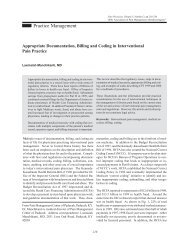ASIPP Practice Guidelines - Pain Physician
ASIPP Practice Guidelines - Pain Physician
ASIPP Practice Guidelines - Pain Physician
Create successful ePaper yourself
Turn your PDF publications into a flip-book with our unique Google optimized e-Paper software.
Manchikanti et al • <strong>ASIPP</strong> <strong>Practice</strong> <strong>Guidelines</strong><br />
33<br />
and/or social history consists of a review of the past history<br />
of the patient including past experiences, illnesses,<br />
operations, injuries, and treatment; family history, including<br />
a review of medical events in the patient’s family, hereditary<br />
diseases, and other factors; and social history appropriate<br />
for age reflecting past and current activities.<br />
Past history in interventional pain medicine includes history<br />
of past pain problems, motor vehicle, occupational,<br />
or nonoccupational injuries; history of headache, neck pain,<br />
upper-extremity pain, pain in the upper, or mid back or<br />
chest wall, pain in the lower back or lower extremities,<br />
and pain in joints; and disorders such as arthritis,<br />
fibromyalgia, or systemic lupus erythematosus.<br />
Family history includes history of pain problems in the<br />
family, degenerative disorders, familial disorders, drug<br />
dependency, alcoholism, or drug abuse; and psychological<br />
disorders such as depression, anxiety, schizophrenia,<br />
and suicidal tendencies, etc. Family history of medical<br />
problems is also important.<br />
Social history includes environmental information, educa-<br />
Table 4. Features of somatic and radicular pain<br />
Somatic or referred pain Radicular pain<br />
i. Causes ♦ Facet joint-mediated pain ♦ Disc herniation<br />
♦ Sacroiliac joint-mediated pain ♦ Annular tear<br />
♦ Myofascial syndrome ♦ Spinal stenosis<br />
♦ Internal disc disruption<br />
ii. Symptoms<br />
Quality ♦ Deep, aching ♦ Sharp, shooting<br />
♦ Poorly localized<br />
♦ Well localized<br />
♦ Back worse than leg ♦ Leg worse than back<br />
♦ No paresthesia<br />
♦ Paresthesia present<br />
♦ Covers a wide area<br />
♦ Well defined area<br />
♦ No radicular or shooting pain ♦ Radicular distribution<br />
Modification ♦ Worse with extension ♦ Worse with flexion<br />
♦ Better with flexion<br />
♦ Better with extension<br />
♦ No radicular pattern<br />
♦ Radicular pattern<br />
Radiation ♦ Low back to hip, thigh, groin ♦ Follows nerve root distribution<br />
♦ Radiation below knee unusual ♦ Radiation below knee common<br />
♦ No radicular pattern<br />
♦ Radicular and shooting pain<br />
iii. Signs<br />
Sensory alterations ♦ Uncommon ♦ Probable<br />
Motor changes ♦ Only subjective weakness ♦ Objective weakness<br />
♦ Atrophy is rare<br />
♦ Atrophy may be present<br />
Reflex changes ♦ None ♦ Commonly described but seen occasionally<br />
Straight leg raises ♦ Only low back pain ♦ Reproduction of leg pain<br />
♦ No root-tension signs ♦ Positive root-tension signs<br />
Adapted and modified from Manchikanti (41)<br />
<strong>Pain</strong> <strong>Physician</strong> Vol. 4, No. 1, 2001
















